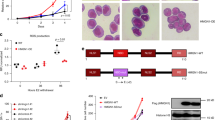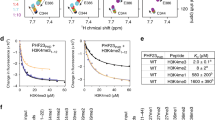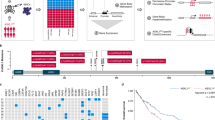Abstract
The AML1-ETO fusion protein, which is present in 10–15% of cases of acute myeloid leukemia, is known to repress myeloid differentiation genes through DNA binding and recruitment of chromatin-modifying proteins and transcription factors in target genes. ChIP-chip analysis of human hematopoietic stem/progenitor cells transduced with the AML1-ETO fusion gene enabled us to identify 1168 AML1-ETO target genes, 103 of which were co-occupied by histone deacetylase 1 (HDAC1) and had lost the hyperacetylation mark at histone H4, and 264 showed a K9 trimethylation at histone H3. Enrichment of genes involved in hematopoietic differentiation and in specific signaling pathways was observed in the presence of these epigenetic modifications associated with an ‘inactive’ chromatin status. Furthermore, AML1-ETO target genes had a significant correlation between the chromatin marks studied and transcriptional silencing. Interestingly, AML1 binding sites were absent on a large number of selected AML1-ETO promoters and an Sp1 binding site was found in over 50% of them. Reversible silencing induced by the fusion protein in the presence of AML1 and/or Sp1 transcription factor binding site was confirmed. Therefore, this study provides a global analysis of AML1-ETO functional chromatin modifications and identifies the important role of Sp1 in the DNA binding pattern of AML1-ETO, suggesting a role for Sp1-targeted therapy in this leukemia subtype.
This is a preview of subscription content, access via your institution
Access options
Subscribe to this journal
Receive 12 print issues and online access
$259.00 per year
only $21.58 per issue
Buy this article
- Purchase on Springer Link
- Instant access to full article PDF
Prices may be subject to local taxes which are calculated during checkout





Similar content being viewed by others
References
Vardiman JW, Harris NL, Brunning RD . The World Health Organization (WHO) classification of the myeloid neoplasms. Blood 2002; 100: 2292–2302.
Peterson LF, Zhang DE . The 8;21 translocation in leukemogenesis. Oncogene 2004; 23: 4255–4262.
Shimada H, Ichikawa H, Ohki M . Potential involvement of the AML1-MTG8 fusion protein in the granulocytic maturation characteristic of the t(8;21) acute myelogenous leukemia revealed by microarray analysis. Leukemia 2002; 16: 874–885.
Meyers S, Downing JR, Hiebert SW . Identification of AML-1 and the (8;21) translocation protein (AML-1/ETO) as sequence-specific DNA-binding proteins: the runt homology domain is required for DNA binding and protein-protein interactions. Mol Cell Biol 1993; 13: 6336–6345.
Yuan Y, Zhou L, Miyamoto T, Iwasaki H, Harakawa N, Hetherington CJ et al. AML1-ETO expression is directly involved in the development of acute myeloid leukemia in the presence of additional mutations. Proc Natl Acad Sci USA 2001; 98: 10398–10403.
Higuchi M, O’Brien D, Kumaravelu P, Lenny N, Yeoh EJ, Downing JR . Expression of a conditional AML1-ETO oncogene bypasses embryonic lethality and establishes a murine model of human t(8;21) acute myeloid leukemia. Cancer Cell 2002; 1: 63–74.
Mulloy JC, Cammenga J, MacKenzie KL, Berguido FJ, Moore MA, Nimer SD . The AML1-ETO fusion protein promotes the expansion of human hematopoietic stem cells. Blood 2002; 99: 15–23.
Mulloy JC, Cammenga J, Berguido FJ, Wu K, Zhou P, Comenzo RL et al. Maintaining the self-renewal and differentiation potential of human CD34+ hematopoietic cells using a single genetic element. Blood 2003; 102: 4369–4376.
Tonks A, Pearn L, Tonks AJ, Pearce L, Hoy T, Phillips S et al. The AML1-ETO fusion gene promotes extensive self-renewal of human primary erythroid cells. Blood 2003; 101: 624–632.
Wang J, Hoshino T, Redner RL, Kajigaya S, Liu JM . ETO, fusion partner in t(8;21) acute myeloid leukemia, represses transcription by interaction with the human N-CoR/mSin3/HDAC1 complex. Proc Natl Acad Sci USA 1998; 95: 10860–10865.
Lutterbach B, Westendorf JJ, Linggi B, Patten A, Moniwa M, Davie JR et al. ETO, a target of t(8;21) in acute leukemia, interacts with the N-CoR and mSin3 corepressors. Mol Cell Biol 1998; 18: 7176–7184.
Amann JM, Nip J, Strom DK, Lutterbach B, Harada H, Lenny N et al. ETO, a target of t(8;21) in acute leukemia, makes distinct contacts with multiple histone deacetylases and binds mSin3A through its oligomerization domain. Mol Cell Biol 2001; 21: 6470–6483.
Gelmetti V, Zhang J, Fanelli M, Minucci S, Pelicci PG, Lazar MA . Aberrant recruitment of the nuclear receptor corepressor-histone deacetylase complex by the acute myeloid leukemia fusion partner ETO. Mol Cell Biol 1998; 18: 7185–7191.
Gardini A, Cesaroni M, Luzi L, Okumura AJ, Biggs JR, Minardi SP et al. AML1-ETO oncoprotein is directed to AML1 binding regions and co-localizes with AML1 and HEB on its targets. PLoS Genet 2008; 4: e1000275.
Follows GA, Tagoh H, Lefevre P, Hodge D, Morgan GJ, Bonifer C . Epigenetic consequences of AML1-ETO action at the human c-FMS locus. EMBO J 2003; 22: 2798–2809.
Zhang J, Kalkum M, Yamamura S, Chait BT, Roeder RG . E protein silencing by the leukemogenic AML1-ETO fusion protein. Science 2004; 305: 1286–1289.
Mao S, Frank RC, Zhang J, Miyazaki Y, Nimer SD . Functional and physical interactions between AML1 proteins and an ETS protein, MEF: implications for the pathogenesis of t(8;21)-positive leukemias. Mol Cell Biol 1999; 19: 3635–3644.
Martens JH, Brinkman AB, Simmer F, Francoijs KJ, Nebbioso A, Ferrara F et al. PML-RARalpha/RXR alters the epigenetic landscape in acute promyelocytic leukemia. Cancer Cell 2010; 17: 173–185.
Durst KL, Hiebert SW . Role of RUNX family in transcriptional repression and gene silencing. Oncogene 2004; 23: 4220–4224.
Bannister AJ, Zegerman P, Partridge JF, Miska EA, Thomas JO, Allshire RC et al. Selective recognition of methylated lysine 9 on histone H3 by the HP1 chromo domain. Nature 2001; 410: 120–124.
Kouzarides T . Chromatin modifications and their function. Cell Rev 2007; 128: 693–705.
Reed-Inderbitzin E, Moreno-Miralles I, Vanden-Eynden SK, Xie J, Lutterbach B, Durst-Goodwin KL et al. RUNX1 associates with histone deacetylases and SUV39H1 to repress transcription. Oncogene 2006; 25: 5777–5789.
Carbone R, Botrugno OA, Ronzoni S, Insinga A, Di Croce L, Pelicci PG et al. Recruitment of the histone methyltransferase SUV39H1 and its role in the oncogenic properties of the leukemia-associated PML-retinoic acid receptor fusion protein. Mol Cell Biol 2006; 26: 1288–1296.
Wei H, Liu X, Xiong X, Wang Y, Rao Q, Wang M et al. AML1-ETO interacts with Sp1 and antagonizes Sp1 transactivity through RUNT domain. FEBS Lett 2008; 582: 2167–2172.
Krejci O, Wunderlich M, Geiger H, Chou FS, Schleimer D, Jansen M et al. p53 signaling in response to increased DNA damage sensitizes AML1-ETO cells to stress-induced death. Blood 2008; 111: 2190–2199.
Ballestar E, Paz MF, Valle L, Wei S, Fraga MF, Espada J et al. Methyl-CpG binding proteins identify novel sites of epigenetic inactivation in human cancer. EMBO J 2003; 22: 6335–6345.
Linggi B, Muller-Tidow C, van de Locht L, Hu M, Nip J, Serve H et al. The t(8;21) fusion protein, AML1 ETO, specifically represses the transcription of the p14(ARF) tumor suppressor in acute myeloid leukemia. Nat Med 2002; 8: 743–750.
Montaner D, Tarraga J, Huerta-Cepas J, Burguet J, Vaquerizas JM, Conde L et al. Next station in microarray data analysis: GEPAS. Nucleic Acids Res 2006; 34 (Web Server issue): W486–W491.
Subramanian A, Tamayo P, Mootha VK, Mukherjee S, Ebert BL, Gillette MA et al. Gene set enrichment analysis: a knowledge-based approach for interpreting genome-wide expression profiles. Proc Natl Acad Sci USA 2005; 102: 15545–15550.
Hellemans J, Mortier G, De Paepe A, Speleman F, Vandesompele J . qBase relative quantification framework and software for management and automated analysis of real-time quantitative PCR data. Genome Biol 2007; 8: R19.
Liu S, Wu LC, Pang J, Santhanam R, Schwind S, Wu YZ et al. Sp1/NFkappaB/HDAC/miR-29b regulatory network in KIT-driven myeloid leukemia. Cancer Cell 2010; 17: 333–347.
Follows GA, Tagoh H, Lefevre P, Hodge D, Morgan GP, Bonifer C . Epigenetic consequences of AML1-ETO action at the human c-FMS locus. EMBO J 2003; 22: 2798–2809.
Novershtern N, Subramanian A, Lawton LN, Mak RH, Haining WN, McConkey ME et al. Densely interconnected transcriptional circuits control cell states in human hematopoiesis. Cell 2011; 144: 296–309.
Gardini A, Cesaroni M, Luzi L, Okumura AJ, Biggs JR, Minardi SP et al. AML1-ETO oncoprotein is directed to AML1 binding regions and co-localizes with AML1 and HEB on its targets. PLOS Genet 2008; 4: 1–12.
Wang L, Gural A, Sun XJ, Zhao X, Perna F, Huang G et al. The leukemogenicity of AML1-ETO is dependent on site-specific lysine acetylation. Science 2011; 333: 765–769.
Figueroa ME, Reimers M, Thompson RF, Ye K, Li Y, Selzer RR et al. An integrative genomic and epigenomic approach for the study of transcriptional regulation. PLoS One 2008; 3: e1882.
Alvarez S, Suela J, Valencia A, Fernandez A, Wunderlich M, Agirre X et al. DNA methylation profiles and their relationship with cytogenetic status in adult acute myeloid leukemia. PLoS One 2011; 5: e12197.
Reed-Inderbitzin E, Moreno-Miralles I, Vanden-Eynden SK, Xie J, Lutterbach B, Durst-Goodwin KL et al. RUNX1 associates with histone deacetylases and SUV39H1 to repress transcription. Oncogene 2006; 25: 5777–5786.
Jakubowiak A, Pouponnot C, Berguido F, Frank R, Mao S, Massague J et al. Inhibition of the transforming growth factor beta 1 signaling pathway by the AML1-ETO leukemia-associated fusion protein. J Biol Chem 2000; 275: 40282–40287.
Geest CR, Coffer PJ . MAPK signaling pathways in the regulation of hematopoiesis. J Leukoc Biol 2009; 86: 237–250.
Pina C, May G, Soneji S, Hong D, Enver T . MLLT3 regulates early human erythroid and megakaryocytic cell fate. Cell Stem Cell 2008; 2: 264–273.
Flygare J, Kiefer T, Miyake K, Utsugisawa T, Hamaguchi I, Da Costa L et al. Deficiency of ribosomal protein S19 in CD34+ cells generated by siRNA blocks erythroid development and mimics defects seen in Diamond-Blackfan anemia. Blood 2005; 105: 4627–4634.
Wampfler J, Tschan MP, Shan D, Laemmle A, Leibundgut EO, Baerlocher GM et al. SIRT1 is downregulated during neutrophil differentiation of acute promyelocytic leukaemia cells. Br J Haematol 2009; 146: 337–341.
Torrano V, Chernukhin I, Docquier F, D’Arcy V, Leon J, Klenova E et al. CTCF regulates growth and erythroid differentiation of human myeloid leukemia cells. J Biol Chem 2005; 280: 28152–28161.
Lakshmikuttyamma A, Scott SA, DeCoteau JF, Geyer CR . Reexpression of epigenetically silenced AML tumor suppressor genes by SUV39H1 inhibition. Oncogene 2010; 29: 576–588.
Wilson NK, Foster SD, Wang X, Knezevic K, Schutte J, Kaimakis P et al. Combinatorial transcriptional control in blood stem/progenitor cells: genome-wide analysis of ten major transcriptional regulators. Cell Stem Cell 2010; 7: 532–544.
Liu S, Liu Z, Xie Z, Pang J, Yu J, Lehmann E et al. Bortezomib induces DNA hypomethylation and silenced gene transcription by interfering with Sp1/NF-kappaB-dependent DNA methyltransferase activity in acute myeloid leukemia. Blood 2008; 111: 2364–2373.
Acknowledgements
We are grateful to Bibiana Ferreira and Ana Del Río for helpful discussions and ideas and M Carmen Martin for the technical work support. We thank Thomas O’Boyle for manuscript review. This work was supported by the Spanish Government; Grant number AP2008-00339 (AMD), PI08-0878 and CP06/0004 (SA), PI08-0440 (JCC), NIH Grant CA118319 (JMC) and Fundacion Cientifica de la Asociacion Española Contra el Cancer.
Author information
Authors and Affiliations
Corresponding author
Ethics declarations
Competing interests
The authors declare no conflict of interest.
Additional information
Author contributions
AMD and SA designed and performed the experiments, analyzed data and prepared the manuscript. FSC, MW and JCM developed all the used HSPC models and provided the expression data. GGL performed bioinformatics analyses. FVJ, SRP, JCC and SA participated on the project design. MJL and MJC provided the primary samples.
Supplementary Information accompanies the paper on the Leukemia website
Supplementary information
Rights and permissions
About this article
Cite this article
Maiques-Diaz, A., Chou, F., Wunderlich, M. et al. Chromatin modifications induced by the AML1-ETO fusion protein reversibly silence its genomic targets through AML1 and Sp1 binding motifs. Leukemia 26, 1329–1337 (2012). https://doi.org/10.1038/leu.2011.376
Received:
Revised:
Accepted:
Published:
Issue Date:
DOI: https://doi.org/10.1038/leu.2011.376
Keywords
This article is cited by
-
AML1/ETO and its function as a regulator of gene transcription via epigenetic mechanisms
Oncogene (2021)
-
ASXL2 is essential for haematopoiesis and acts as a haploinsufficient tumour suppressor in leukemia
Nature Communications (2017)
-
Truncated RUNX1 protein generated by a novel t(1;21)(p32;q22) chromosomal translocation impairs the proliferation and differentiation of human hematopoietic progenitors
Oncogene (2016)
-
AML1/ETO cooperates with HIF1α to promote leukemogenesis through DNMT3a transactivation
Leukemia (2015)
-
Origins of aberrant DNA methylation in acute myeloid leukemia
Leukemia (2014)



